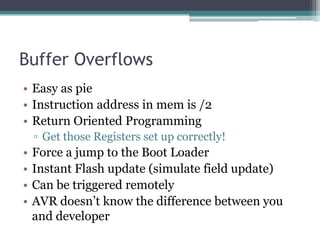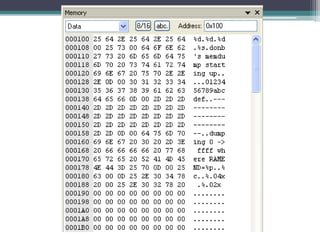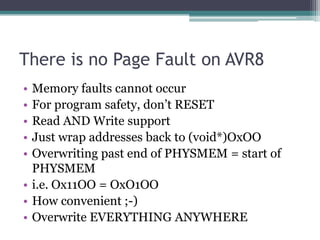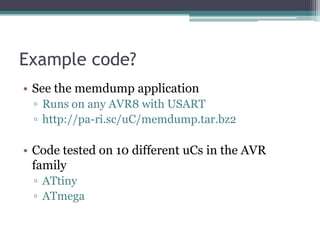Micro control idsecconf2010
- 1. Micro Control Attacking uC Applications Don A. Bailey (donb@isecpartners.com)
- 2. whois donb?
- 3. What’s this uC thing all about? • Single integrated computer • Processor, volatile, non-volatile storage ▫ All In One • Can drive many peripherals • Easily programmable • Field update/upgrade capability • Personalization (EEPROM)
- 4. No, really… Why do I care? • Your car • Implanted medical devices ▫ WBAN (Wireless Body Area Network) • Crops monitoring (hydro/aero/enviro-ponics) • Infrastructure monitoring (SCADA, etc) • “Smart Dust” • Access controls (RFID, biometrics, etc)
- 5. Now with More Networking! • Bluetooth • USB • 802.11 • 802.15.4 • RFID • DECT • GSM
- 6. Security? • Some tamper resistance • Hardware security • From a software point of view? ▫ Crypto support ▫ …?
- 7. OODA Loop? • Field upgrades are rare ▫ But getting more common ▫ ST M24LR64 Dual EEPROM (Leet!!) • Most firmware is legacy code • Spot updates for new functionality / peripherals • Mostly written in C, C++, and/or ASM
- 8. Why wouldn’t you PWN an uC?
- 9. Prior work? • Travis Goodspeed ▫ GoodFET, neighbor! • Josh Wright ▫ Killerbee!
- 10. Picking on Atmel AVR8
- 11. Lots of uC out there, but… • Popular with hackers and engineers • Free toolchain (gcc based) • Free IDE (AVR Studio 4) • No Soldering necessary • Relatively cheap dev tools ▫ AVRISP mkII (~30 USD) ▫ AVR JTAGICE mkII (good deals from Arrow Electronics)
- 14. Typically included in AVR8 • ALU • Flash • SRAM • EEPROM • Peripheral support (USART, SPI, I2C, TWI, etc)
- 16. That’s right, it’s Harvard • Separate Data and Code lines • Code always retrieved from Flash • Data always retrieved from SRAM • Flash can be written in software ▫ Typically Boot Loader Support ▫ Fuses determine this ▫ Some AVR8 don‟t support this
- 17. Point? • Attack data, not instructions • Return-to-whatever (ROP :-P) • Easier! Less data to inject (typically) • Takes longer • That‟s what GoodFET is for ▫ Snatch one Smart Dust sensor ▫ GoodFET ▫ Analyze code ▫ Build ROP strategy ▫ Own 100 more remotely
- 19. Typical AVR8 Stuff? • Interrupts • Atomic Execution (sort of ;-) • Stack • 32 8-bit registers • LSB • 8/16/32/64-bit integer support • Access to I/O mem • RISC
- 20. What doesn’t AVR8 have? • Security boundaries • Contexts (multiple stacks) • Concurrency • Segmentation/Paging • No atomic instructions (cmpxchg?) • Native 32/64-bit integer support • Exceptions ▫ Where‟s the Page Fault, yo?!
- 21. Let’s Talk Program Flow
- 22. Typical programmatic flow • Reset • Init • Main • somefunc
- 23. On startup • AVR sets PC to OxOO in Flash • OxOO = Reset Vector • JMP to init in crtO • Init does stuff… • Call main • Do stuff… • Call somefunc • Do more stuff…
- 24. From RESET -> main()
- 26. crt0 Copy of .rodata
- 28. Stack Dump After Call to main()
- 30. Function Call
- 34. Four Main Points Demonstrated… • Function conventions are typical ▫ Optimization may minimize this • Code Layout • Data Layout • Atomic Code Sections
- 35. Code Layout in Flash • Interrupt Vectors at OxOO • RESET Vector at OxOO • Main Application Code • Data (???) • Boot Loader Section ▫ Can write to Flash (if Fuses allow) for field updates
- 36. Data Layout in SRAM • Registers at OxOO • I/O Memory at Ox2O • Extended I/O Memory • Data (copied from Flash) at Ox1OO • BSS • Heap • Stack • ??? ;-)
- 37. Atomicity • CLI used • SREG can be accessed via SRAM (I/O memory) • 1 CPU Cycle to write to SREG • Flow: ▫ Save a copy of SREG ▫ Clear Interrupt Bit in SREG ▫ Perform uninterrupted action Write to low byte of SP Write to SREG (old state with interrupt bit set) Write to high byte of SP
- 38. Now, Let’s Have Some Real Fun
- 39. Entropy? What entropy? • Randomness is very weak • Crypto hurt as a result • Pools can be accumulated ▫ “True Random Number Generator On an Atmel uC” – IEEE Paper • 8 Random Bits using RC oscillator ▫ Per second!!!
- 40. Race Conditions • No semblance of context switching ▫ TinyOS/Contiki simulate it • Critical Sections secured through CLI • Attack these sections ▫ Overwrite SREG; enable Interrupts • Use Interrupts to cause unexpected behavior
- 41. Return Value Checks • Snprintf returning <=O or >= sizeof buf? • Logic Issue • Always a problem
- 42. memcpy and Friends • Latest avr-libc • Don‟t test for negative size values • No option to “secure” with CLI ▫ Interruptable ▫ Oops…Where‟d my SP go?! ;-)
- 43. Buffer Overflows • Easy as pie • Instruction address in mem is /2 • Return Oriented Programming ▫ Get those Registers set up correctly! • Force a jump to the Boot Loader • Instant Flash update (simulate field update) • Can be triggered remotely • AVR doesn‟t know the difference between you and developer
- 44. Frame Pointer Overwrite • Standard FP overwrite • Point stack to attacker controlled data • Next frame has the RET • FP saved LSB first
- 45. Setjmp • Obvious target • Often used • Makes up for lack of exceptions • Saves entire program state • Overwrite all registers • Overwrite PC
- 46. Integer Overflows • Work as expected • 8-bit registers • 16-bit native instructions • Easy to wrap OxFFFF
- 47. Integer Promotion • Normal integer promotion • Unsigned -> Signed = No Sign Extension • Signed -> Signed = Sign Extension • Stop using „char‟ for everything ;-) • Lots of 8-bit networking protocols ▫ 8-bit size fields ▫ Promoted to int during packet ingestion ▫ Oops!!
- 48. Heap Overflows • Heap Struct consists of { size, Next* } • Next* points to the next free heap chunk • Adjacent chunks are combined • No function pointers • Easily mangle data • Next* doesn‟t have to point to Heap • Heap data isn‟t zeroed on free() • Easy way to create pseudo stack frames • ROP Helper!
- 49. Double Free • Latest avr-libc free() doesn‟t check • Any address can be used (except NULL) • Free() will happily overwrite first 2 bytes with ▫ Next* • Add it to the free list ;-) • Can stealthily force malloc() to return (void*)OxOO • Write direct to Registers, I/O memory, etc • ROP Helper!!
- 50. “Segment” Collision • Heap is allocated slightly under stack • Stack is dynamic!!! • BSS is adjacent to Heap • .rodata isn‟t Read Only! Adjacent to BSS • One big happy family!
- 51. Uninitialized Variables • Allocate a large Heap chunk • Spray with OxAABB • Stack decends into Heap • Bewm! • Example code at: ▫ http://pa-ri.sc/uC/dangle.tar.bz2
- 52. Format Strings • Current avr-libc has no %n support • No fun • But, kind of reasonable
- 53. NULL Pointer Dereferences • There are no privilege rings, but still useful • Functions like malloc() still return NULL • (void*)OxOO points to Registers in SRAM • NULL deref is a very good thing • Like free() bug, instant access to Regs, I/O Mem • On the flip side… ▫ ??? ;-)
- 54. Beyond Memory • Deref beyond physical memory addresses? • Example: ATmega644P ▫ 4096 bytes SRAM ▫ Total 4196 addressable bytes With registers, I/O memory • Ox1OFF should be highest addressible address
- 58. There is no Page Fault on AVR8 • Memory faults cannot occur • For program safety, don‟t RESET • Read AND Write support • Just wrap addresses back to (void*)OxOO • Overwriting past end of PHYSMEM = start of PHYSMEM • i.e. Ox11OO = OxO1OO • How convenient ;-) • Overwrite EVERYTHING ANYWHERE
- 59. Example code? • See the memdump application ▫ Runs on any AVR8 with USART ▫ http://pa-ri.sc/uC/memdump.tar.bz2 • Code tested on 10 different uCs in the AVR family ▫ ATtiny ▫ ATmega
- 60. We Pack and Deliver like UPS Trucks
- 61. Summary? • Ripe environment for application vulnerabilities • Little protection schemes ▫ Except solid auditing and a tight SDLC • Lots of legacy code in the field • Lots of important devices
- 62. Special thanks… • Jim Geovedi • Y3dips • Kendi Demonic • Abdul Azis • Dhillon Kannabhiran • iSEC Partners • Nick DePetrillo • Mike Kershaw • Travis Goodspeed • Josh Wright































































